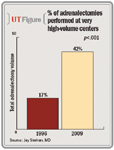Article
Adrenalectomies on the rise in high-volume centers
Higher-volume centers tend to treat adrenalectomy patients who are younger, have a shorter length of stay, and are less likely to die in the hospital when compared to patients treated at lower-volume centers. Researchers found that very low-volume centers treat patients who are older, more likely to be female, and covered by Medicaid or uninsured.

Key Points
San Francisco-The regionalization of care is shifting patients undergoing adrenalectomy to higher-volume centers, data from a recent multicenter study indicate.
Such centers tend to treat patients who are younger, have a shorter length of stay, and are less likely to die in the hospital when compared to patients treated at lower-volume centers. Researchers found that very low-volume centers treat patients who are older, more likely to be female, and covered by Medicaid or uninsured.
"We saw a significant shift toward higher-volume centers," said first author Jay Simhan, MD, a urology resident at Fox Chase Cancer Center, Philadelphia, working with Alexander Kutikov, MD, and colleagues. "We know that centralization of care has been demonstrated in non-urologic surgeries such as pancreatectomy, esophagectomy, and colectomy, but to date trends in urologic procedures such as adrenalectomy have been poorly defined."
Researchers at the Fox Chase Cancer Center and the University of North Carolina, Chapel Hill, used hospital discharge data from New Jersey, New York, and Pennsylvania from 1996 to 2009 to determine the extent of regionalization for adrenal surgery. A total of 8,381 patients 18 years of age and older undergoing adrenalectomy were identified using ICD-9 coding.
Hospitals were divided into five groups based on 1996 surgical volume: very low (no or one procedures), low (two or three procedures), medium (four to six procedures), high (seven to 14 procedures), and very high (15 or more procedures per year).
Patients were assessed by demographics, payer, length of stay, disposition on discharge, and inpatient mortality. Nearly all of the patients (95%) were discharged to home and fewer than 1% died in the hospital. A total of 63% of patients had private insurance, 25% had Medicare, 9% had Medicaid, 2% were uninsured, and payer status was unknown for the rest. Just under half of patients (49%) were 55 years of age or older and nearly three-fourths (73%) were Caucasian.
'Significant' regionalization observed

Researchers found equally clear differences in patient characteristics when stratified by hospital volume. Compared to very high-volume hospitals, patients at very low-volume hospitals were significantly more likely to be 55 years of age or older, less likely to be Asian, less likely to be male, and more likely to be on Medicare or uninsured (p<.001).
Improved outcomes were also observed in patients treated at higher-volume hospitals. Compared to very low-volume institutions, the odds ratio for inpatient mortality was 0.66 at low-volume hospitals (p=.04), 0.44 at medium-volume hospitals (p=.002), 0.26 at high-volume hospitals (p=.001), and 0.38 at very high-volume hospitals (p=.006). Similarly, the median length of stay was 0.86 days shorter at low-volume hospitals, 0.94 days shorter at medium-volume hospitals, 1.68 days less at high-volume hospitals, and 1.75 days less at very high-volume hospitals (p<.001).
Access disparities warrant further study
"These data demonstrate that regionalization of adrenalectomy is occurring despite the lack of regulatory guidance. We saw improved outcomes in patients treated at higher-volume centers, as well as clear disparities in access to higher-volume centers," Dr. Simhan said. "These trends should be the focus of further investigation."
More research is the next step, agreed study discussant Raj S. Pruthi, MD, professor and chief of urology at the University of North Carolina School of Medicine.
"The concept of regionalization is very interesting and provocative," said Dr. Pruthi, who was not involved with the study. "This being administrative data, it is tough to draw conclusions for patient benefit from high-volume centers."
If regionalization does improve patient care, Dr. Pruthi noted, improvements are likely to be uneven. It is relatively easy to centralize care in the Northeast, where population density and hospital density are high and transfer between centers means short trips. Centralization might not be practical in parts of the Midwest and West, where population densities are low and transfer between centers could require long travel times.
Newsletter
Stay current with the latest urology news and practice-changing insights — sign up now for the essential updates every urologist needs.















